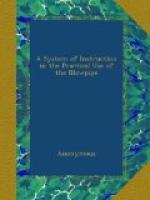Microcosmic Salt dissolves oxide of bismuth upon platinum wire, in the flame of oxidation, to a yellow bead, which becomes colorless after cooling. By the addition of more oxide, the bead is yellowish-brown while hot, and colorless after cooling, but not quite transparent. This bead becomes enamelled when heated by the intermittent flame; also, by the addition of still more of the oxide, after it is cooled.
Upon charcoal, in the flame of reduction, and particularly with the addition of tin, the bead is colorless and transparent while hot, but while cooling becomes of a dark-gray color and opaque.
Oxide of bismuth is reduced, by fusion with carbonate of soda, as well in the oxidating as in the reducing flame, instantly to metallic bismuth.
As the above mentioned higher oxides of bismuth are converted by ignition into oxide of the metal and free oxygen, they have the same behavior before the blowpipe.
As bismuth occurs mostly in the metallic form, it is necessary to know how to distinguish it from metals similar to it. Its brittleness distinguishes it from lead, zinc and tin, as they are readily flattened by a stroke of the hammer, while bismuth is broken to pieces. Bismuth, in this latter respect, might perhaps be mistaken for antimony or tellurium; but, by the following examination, it is easy to separate bismuth from antimony or tellurium.
1. Neither bismuth nor antimony sublimates when heated in a glass tube closed at one end. At a temperature which is about to fuse the glass, tellurium yields a small quantity of a white vapor (some tellurium is oxidized to tellurous acid by the oxygen of the air in the tube). After that, a grey metallic sublimate settles on the sides of the tube.
2. Heated in an open tube, antimony yields a white vapor, which coats the inside of the glass tube, and can be driven by heat from one part of the tube to another without leaving a residue. The metallic globule is covered with a considerable quantity of fused oxide. Tellurium produces, under the same circumstances, an intense vapor, and deposits on the glass a white powder, which melts by heat into globules that run over the glass. The metallic globules are covered by fused, transparent, and nearly colorless oxide, which becomes white while cooling. By a high temperature, and with little access of air, metallic tellurium sublimes with the deposition of a grey powder. Bismuth produces, under similar treatment, scarcely any vapor, unless it is combined with sulphur. The metal is enveloped by fused oxide of a dark yellow color, which appears light yellow after being cooled. It acts upon the glass, and dissolves it.
3. Upon charcoal, exposed to the blowpipe flame, the three metals are volatilized, and yield a sublimate upon the charcoal. That of antimony is white, while those of bismuth and tellurium are dark yellow. By exposing them to the flame of reduction, the sublimate of tellurium disappears and communicates an intense green color to the flame. The antimony incrustation gives a feeble greenish-blue color, while the sublimate of bismuth gives no perceptible color in the light. It is, however, worthy of notice that if the operation takes place in the dark, a very pale blue flame will be seen with the bismuth.




